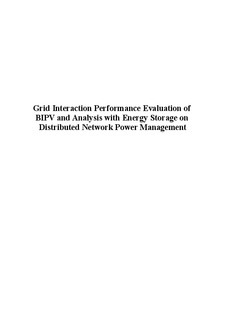| dc.contributor.author | Azmi, Aimie Nazmin | |
| dc.date.accessioned | 2017-03-06T11:53:13Z | |
| dc.date.available | 2017-03-06T11:53:13Z | |
| dc.date.issued | 2017 | |
| dc.identifier.isbn | 978-82-7117-848-2 | |
| dc.identifier.issn | 1504-9272 | |
| dc.identifier.uri | http://hdl.handle.net/11250/2433000 | |
| dc.description | Doktorgradsavhandling ved Universitetet i Agder, Institutt for informasjons- og kommunikasjonsteknologi, 2017 | nb_NO |
| dc.description.abstract | This research focuses on analysis of photovoltaic (PV) based active generator in microgrid and its utilization in not only for operational planning of the power system but also for instantaneous power flow management in the smart grid environment. The application of this system is part of a solution on handling a large scale deployment of grid connected distributed generators, especially PV system. By implementing the PV based active generator, it will be very flexible able to manage the power delivery from the active generator sources (e.g. PV system, energy storage technologies, active power conditioning devices). In Southern Norway, a smart village Skarpnes is developed for ZEBs. These ZEBs have Building Integrated Photovoltaic (BIPV) system. The energy efficient housing development should consider that a building should produce the same amount of electrical energy as its annual requirements (i.e. ZEB). In future, ZEBs are going to play a significant role in the upcoming smart grid development due to their contribution on the on-site electrical generation, energy storage, demand side management etc. In this work the main objective is to evaluate the usefulness of ZEBs for load matching with BIPV generation profiles and grid interaction analysis. Impact of BIPV system has been investigated on the distributed network power flow as well as on protection and protective relays analysis. Furthermore, techno-economic analysis of BIPV system is presented which will be useful to the utility for developing new business models as well as demand side management (DSM) strategies and for decentralized energy storage. The real operational results of a year are analyzed for annual energy balance with on-site BIPV generation and local load. This work provides quantitative analysis of various grid interaction parameters suitable to describe energy performance of the BIPV. The load matching and grid interaction parameters are calculated for a house to find relationship of BIPV generation and building load. The loss of load probability is analyzed for fulfilling the local load at desired reliability level. Results of this work are going to be useful for developing DSM strategies and energy storage as well as import/export energy to the grid. This work will be beneficial for future planning of the distributed network when the BIPV penetrations are going to increase. | nb_NO |
| dc.language.iso | eng | nb_NO |
| dc.publisher | Universitet i Agder / University of Agder | nb_NO |
| dc.relation.ispartofseries | Doctoral dissertations at University of Agder;154 | |
| dc.title | Grid Interaction Performance Evaluation of BIPV and Analysis with Energy Storage on Distributed Network Power Management | nb_NO |
| dc.type | Doctoral thesis | nb_NO |
| dc.subject.nsi | VDP::Technology: 500::Information and communication technology: 550 | nb_NO |
| dc.source.pagenumber | VI, 146 | nb_NO |
